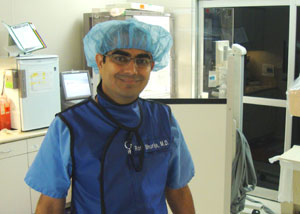
Since minimally invasive cardiac catheterization was pioneered in the 1950s, the procedure has traditionally been performed by threading a thin tube through the femoral artery in the groin guided by X-rays toward the heart, using the circulatory system to clear blockages, deliver medication, and place stents.
However, numerous studies and clinical trials have proven that using blood vessels through an artery in the wrist, instead of an artery in the leg, offer many advantages.
“Inserting the catheter through the radial artery in the wrist, rather than through the groin, has been shown to markedly reduce major vascular complications,” said Rohit Bhuriya, M.D., an interventional cardiologist affiliated with Memorial Hermann Southeast. “Patients usually are able to sit up and walk around immediately after the procedure, rather than lying on their backs for many hours which was typical with the traditional method.”
Radial artery catheterization near the thumb side of the wrist is safer because the radial artery is located closer to the skin's surface. A wristband is used to compress the artery when the procedure is finished.
“The wrist location allows bleeding complications to be spotted sooner,” said Bhuriya. “And blood loss from the radial artery is simply compressed with a finger.”
An option available at Memorial Hermann Southeast for more than four years, women benefit even more from the radial artery approach. A recent study of more than 1,700 catheterizations in women showed the rates of bleeding or vascular complications were 59 percent lower.
Patients at Memorial Hermann Southeast are cared for by a multi-disciplinary, experienced team of board certified cardiologists, interventional cardiologists, and vascular surgeons specifically trained in the technically challenging radial approach. Each patient’s specific needs and disease stage are used to formulate an individualized treatment plan.
“As with every procedure, we evaluate each patient’s case carefully to determine the best type of procedure to perform,” said Bhuriya. “We encourage patients to ask our team about this form of diagnostic testing to see if it is appropriate for them.”
With a Chest Pain Center accredited by the Society for Chest Pain Centers, Memorial Hermann Southeast’s comprehensive Heart and Vascular Program includes noninvasive cardiology, peripheral invasive cardiology, peripheral vascular surgery, and cardiac rehabilitation. The only hospital in southeast Houston listed on the Transradial Hospital Locator website, Memorial Hermann Southeast offers three cardiac catheterization labs, complete with electrophysiology capabilities, to provide an array of diagnostic and interventional procedures.